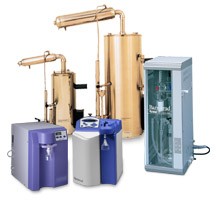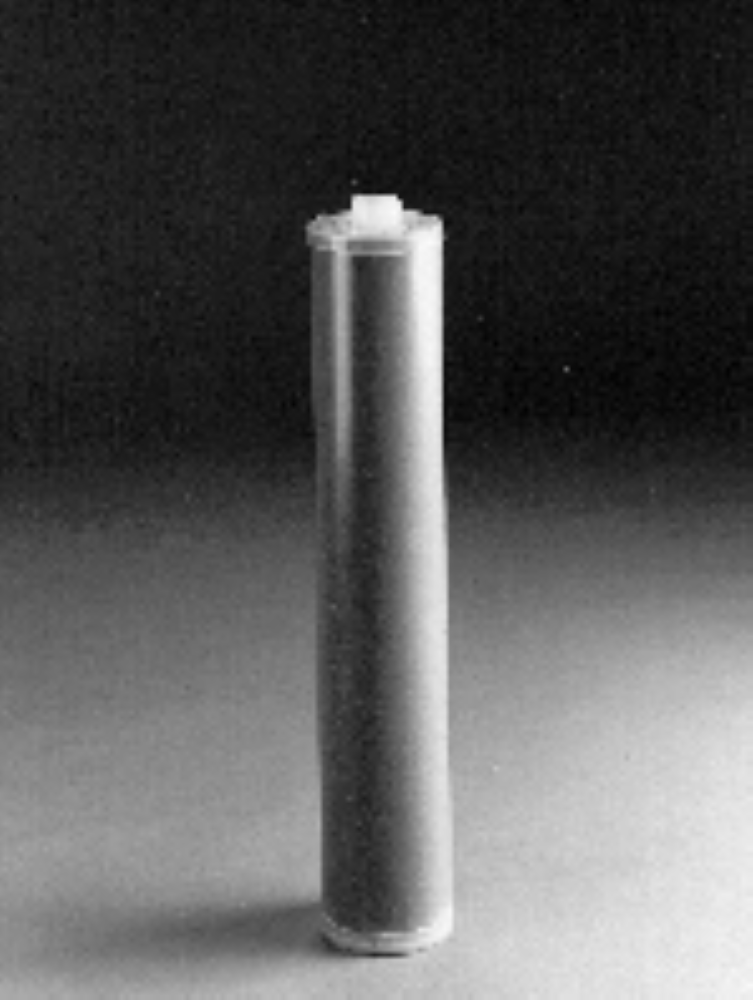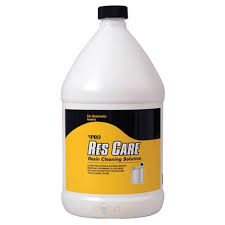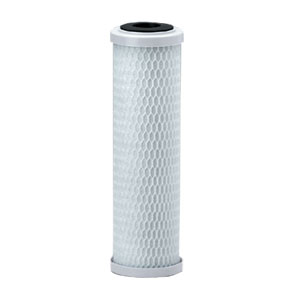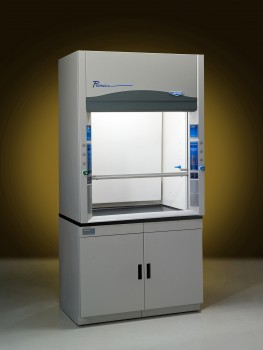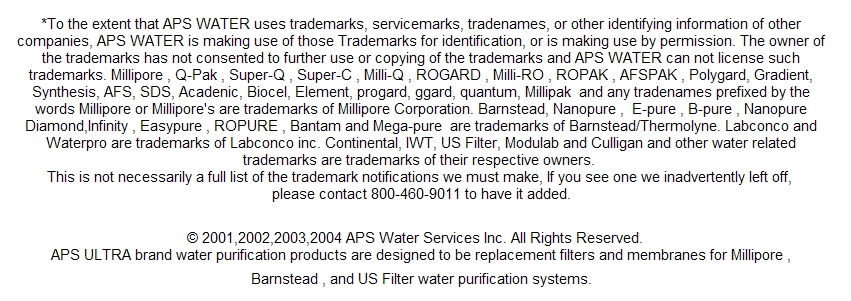Also see :
Physical Characteristics of water
Inorganic Compounds (dissolved metals)
Aluminum
Occurs naturally in some rocks and drainage from mines.
Can precipitate out of water after treatment, causing increased turbidity or discolored water.
Treat with :
Reverse Osmosis
Ion Exchange
Distillation
Precipitaion
Antimony
Enters environment from natural weathering, industrial production, municipal waste disposal, and manufacturing of flame retardants, ceramics, glass, batteries, fireworks, and explosives. Decreases longevity, alters blood levels of glucose and cholesterol in laboratory animals exposed at high levels over their lifetime.
Treat with :
Reverse Osmosis
Ion Exchange
Distillation
Precipitaion
Arsenic
Enters environment from natural processes, industrial activities, pesticides, and industrial waste, smelting of copper, lead, and zinc ore. Causes acute and chronic toxicity, liver and kidney damage; decreases blood hemoglobin. Possible carcinogen.
Treat with :
Reverse Osmosis
Ion Exchange
Distillation
Precipitaion
Barium
Occurs naturally in some limestones, sandstones, and soils in the eastern United States. Can cause a variety of cardiac, gastrointestinal, and neuromuscular effects. Associated
with hypertension and cardiotoxicity in animals.
Treat with :
Reverse Osmosis
Ion Exchange
Distillation
Precipitaion
Beryllium
Occurs naturally in soils, ground water, and surface water. Often used in electrical industry equipment and components, nuclear power and space industry. Enters the environment from mining operations, processing plants, and improper waste disposal. Found in low concentrations in rocks, coal, and petroleum and enters the ground and causes acute and chronic toxicity; can cause damage to lungs and bones. Possible carcinogen.
Treat with :
Reverse Osmosis
Ion Exchange
Distillation
Precipitaion
Cadmium
Found in low concentrations in rocks, coal, and petroleum and enters the ground and surface water when dissolved by acidic waters. May enter the environment from industrial discharge, mining waste, metal plating, water pipes, batteries, paints and pigments, plastic stabilizers, and landfill leachate. Replaces zinc biochemically in the body and causes high blood pressure, liver and kidney damage, and anemia. Destroys testicular tissue and red blood cells. Toxic to aquatic biota.
Treat with :
Reverse Osmosis
Ion Exchange
Distillation
Precipitaion
Chloride
Chloride is not the same as Chlorine. May be associated with the presence of sodium in drinking water when present in high concentrations. Often from saltwater intrusion, mineral dissolution, industrial and domestic waste. Deteriorates plumbing, water heaters, and municipal water-works equipment at high levels. Above secondary maximum contaminant level, taste becomes noticeable.
Treat with :
Reverse Osmosis
Ion Exchange
Distillation
Precipitaion
Chromium
Enters environment from old mining operations runoff and leaching into ground water, fossil-fuel combustion, cement-plant emissions, mineral leaching, and waste incineration. Used in metal plating and as a cooling-tower water additive. Chromium III is a nutritionally essential element. Chromium VI is much more toxic than Chromium III and causes liver and kidney damage, internal hemorrhaging, respiratory damage, dermatitis, and ulcers on the skin at high concentrations.
Treat with :
Reverse Osmosis
Ion Exchange
Distillation
Precipitaion
Copper
Enters environment from metal plating, industrial and domestic waste, mining, and mineral leaching. Can cause stomach and intestinal distress, liver and kidney damage, anemia in high doses. Imparts an adverse taste and significant staining to clothes and fixtures. Essential
trace element but toxic to plants and algae at moderate levels.
Treat with :
Reverse Osmosis
Ion Exchange
Distillation
Precipitaion
Cyanide
Often used in electroplating, steel processing, plastics, synthetic fabrics, and fertilizer production; also from improper waste disposal. Poisoning is the result of damage to spleen, brain, and liver.
Treat with :
Reverse Osmosis
Ion Exchange
Distillation
Precipitaion (for Complexed Cyanide)
Chlorinatation (for Free Cyanide)
Dissolved solids
Occur naturally but also enters environment from man-made sources such as landfill leachate, feedlots, or sewage. A measure of the dissolved “salts” or minerals in the water. May also include some dissolved organic compounds. May have an influence on the acceptability of water in general. May be indicative of the presence of excess concentrations of specific substances not included in the Safe Water Drinking Act, which would make water objectionable. High concentrations of dissolved solids shorten the life of hot water heaters.
Treat with :
Reverse Osmosis
Ion Exchange
Distillation
Precipitaion
Fluoride
Occurs naturally or as an additive to municipal water supplies; widely used in industry. Decreases incidence of tooth decay but high levels can stain or mottle teeth. Causes crippling bone disorder (calcification of the bones and joints) at very high levels.
Treat with :
Reverse Osmosis
Ion Exchange
Distillation
Hardness
Result of metallic ions dissolved in the water; reported as concentration of calcium carbonate. Calcium carbonate is derived from dissolved limestone or discharges from operating or abandoned mines. Decreases the lather formation of soap and increases scale formation in hot-water heaters and low-pressure boilers at high levels.
Treat with :
Reverse Osmosis
Chemical Injection (acid)
Ion Exchange (Water Softener)
Distillation
Iron
Occurs naturally as a mineral from sediment and rocks or from mining, industrial waste, and corroding metal. Imparts a bitter astringent taste to water and a brownish color to laundered clothing and plumbing fixtures.
Treat with :
Reverse Osmosis
Ion Exchange (Water Softener)
Distillation
Precipitaion
Oxidation
Lead
Enters environment from industry, mining, plumbing, gasoline, coal, and as a water
additive. Affects red blood cell chemistry; delays normal physical and mental development in
babies and young children. Causes slight deficits in attention span, hearing, and learning
in children. Can cause slight increase in blood pressure in some adults. Probable carcinogen.
Treat with :
Reverse Osmosis
Ion Exchange
Distillation
Manganese
Occurs naturally as a mineral from sediment and rocks or from mining and industrial waste. Causes aesthetic and economic damage, and imparts brownish stains to laundry. Affects taste of water, and causes dark brown or black stains on plumbing fixtures. Relatively non-toxic to animals but toxic to plants at high levels.
Treat with :
Reverse Osmosis
Ion Exchange
Distillation
Mercury
Occurs as an inorganic salt and as organic mercury compounds. Enters the environment from industrial waste, mining, pesticides, coal, electrical equipment (batteries, lamps, switches), smelting, and fossil-fuel combustion. Causes acute and chronic toxicity. Targets the kidneys and can cause nervous system disorders.
Treat with :
Reverse Osmosis
Ion Exchange
Distillation
Precipitaion
Nickel
Occurs naturally in soils, ground water, and surface water. Often used in electroplating, stainless steel and alloy products, mining, and refining. Damages the heart and liver of laboratory animals exposed to large amounts over their lifetime.
Treat with :
Reverse Osmosis
Ion Exchange
Distillation
Precipitaion
Nitrate (as nitrogen)
Occurs naturally in mineral deposits, soils, seawater, freshwater systems, the atmosphere, and biota. More stable form of combined nitrogen in oxygenated water. Found in the highest levels in ground water under extensively developed areas. Enters the environment from fertilizer, feedlots, and sewage. Toxicity results from the body’s natural breakdown of nitrate to nitrite. Causes “bluebaby disease,” or methemoglobinemia, which threatens oxygen-carrying capacity of the blood.
Treat with :
Reverse Osmosis
Ion Exchange
Distillation
Nitrite (combined nitrate/nitrite)
Enters environment from fertilizer, sewage, and human or farm animal waste. Toxicity results from the body’s natural breakdown of nitrate to nitrite. Causes “bluebaby disease,” or methemoglobinemia, which threatens oxygen-carrying capacity of the blood.
Treat with :
Reverse Osmosis
Ion Exchange
Distillation
Precipitaion
Selenium
Enters environment from naturally occurring geologic sources, sulfur, and coal. Causes acute and chronic toxic effects in animals--”blind staggers” in cattle. Nutritionally essential element at low doses but toxic at high doses.
Treat with :
Reverse Osmosis
Ion Exchange
Distillation
Silver
Enters environment from ore mining and processing, product fabrication, and disposal. Often used in photography, electric and electronic equipment, sterling and electroplating, alloy, and solder. Because of great economic value of silver, recovery practices are typically used to minimize loss. Can cause argyria, a blue-gray coloration of the skin, mucous membranes, eyes, and organs in humans and animals with chronic exposure.
Treat with :
Reverse Osmosis
Ion Exchange
Distillation
Sodium
Derived geologically from leaching of surface and underground deposits of salt and decomposition of various minerals. Human activities contribute through de-icing and washing products. Can be a health risk factor for those individuals on a low-sodium diet.
Treat with :
Reverse Osmosis
Ion Exchange
Distillation
Sulfate
Elevated concentrations may result from saltwater intrusion, mineral dissolution, and domestic or industrial waste. Forms hard scales on boilers and heat exchangers; can change the taste of water, and has a laxative effect in high doses.
Treat with :
Reverse Osmosis
Ion Exchange
Distillation
Precipitaion
Thallium
Enters environment from soils; used in electronics, pharmaceuticals manufacturing, glass, and alloys. Damages kidneys, liver, brain, and intestines in laboratory animals when given in high doses over their lifetime.
Treat with :
Reverse Osmosis
Ion Exchange
Distillation
Precipitaion
Zinc
Found naturally in water, most frequently in areas where it is mined. Enters environment from industrial waste, metal plating, and plumbing, and is a major component of sludge. Aids in the healing of wounds. Causes no ill health effects except in very high doses. Imparts an undesirable taste to water. Toxic to plants at high levels.
Treat with :
Reverse Osmosis
Ion Exchange
Distillation
Organic Compounds
Volatile organic compounds
Enter environment when used to make plastics, dyes, rubbers, polishes, solvents, crude oil, insecticides, inks, varnishes, paints, disinfectants, gasoline products, pharmaceuticals, preservatives, spot removers, paint removers, degreasers, and many more. Can cause cancer and liver damage, anemia, gastrointestinal disorder, skin irritation, blurred vision, exhaustion, weight loss, damage to the nervous system, and respiratory tract irritation.
Treat with :
Reverse Osmosis
Ion Exchange
Distillation
Activated Carbon
Pesticides
Enter environment as herbicides, insecticides, fungicides, rodenticides, and algicides. Cause poisoning, headaches, dizziness, gastrointestinal disturbance, numbness, weakness, and cancer. Destroys nervous system, thyroid, reproductive system, liver, and kidneys.
Treat with :
Reverse Osmosis
Ion Exchange
Distillation
Activated Carbon
Plasticizers, chlorinated solvents, benzo[a]pyrene, and dioxin
Used as sealants, linings, solvents, pesticides, plasticizers, components of gasoline, disinfectant, and wood preservative. Enters the environment from improper waste disposal, leaching runoff, leaking storage tank, and industrial runoff. Cause cancer. Damages nervous and reproductive systems, kidney, stomach, and liver.
Treat with :
Reverse Osmosis
Ion Exchange
Distillation
Activated Carbon
Microbiological contaminants found in ground water
Coliform bacteria
Occur naturally in the environment from soils and plants and in the intestines of humans and other warm-blooded animals. Used as an indicator for the presence of pathogenic bacteria, viruses, and parasites from domestic sewage, animal waste, or plant or soil material. Bacteria, viruses, and parasites can cause polio, cholera, typhoid fever, dysentery, and infectious hepatitis.
Treat with :
Reverse Osmosis
Distillation
Chlorinationation
Ultraviolet Radiation
Submicron Filtration
Ultrafiltration
Radiological contaminants found in ground water
Gross alpha-particle activity
A category of radioactive isotopes. Occurs from either natural or man-made sources including weapons, nuclear reactors, atomic energy for power, medical treatment and diagnosis, mining radioactive material, and naturally occurring radioactive geologic formations. Primary concern is natural sources, which are ubiquitous in the environment (Durrance, 1986); secondary concern is man-made sources. Damages tissues and destroys bone marrow.
Treat With :
Reverse Osmosis
Airation
Ion Exchange
Combined radium-226 and radium-228
Enters environment from natural and man-made sources. Historical industrial-waste sites are the main man-made source. Causes cancer by concentrating in the bone and skeletal tissue.
Treat With :
Ion Exchange
Beta-particle and photon radioactivity
A category of radioactive isotopes from either natural or man-made sources including weapons, nuclear reactors, atomic energy for power, medical treatment and diagnosis, mining radioactive material, and naturally occurring radioactive geologic formations. Primary concern is man-made sources because of widespread use (Durrance, 1986); secondary concern is natural sources. Damages tissues and destroys bone marrow.
Treat With :
Ion Exchange
http://ga.water.usgs.gov/edu/earthgwquality.html
|
